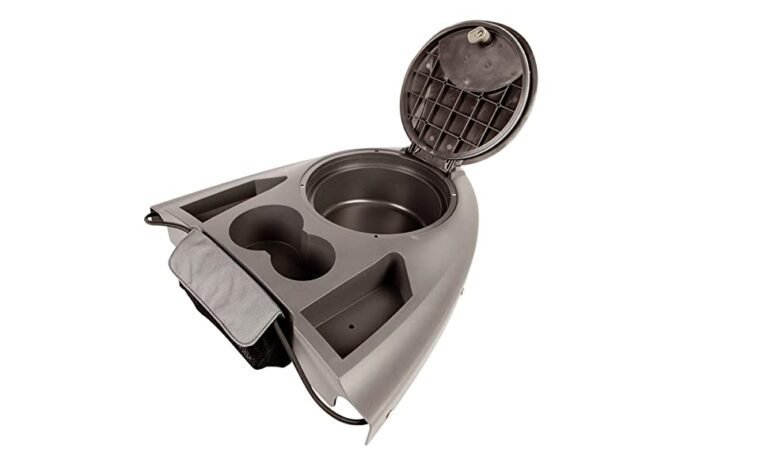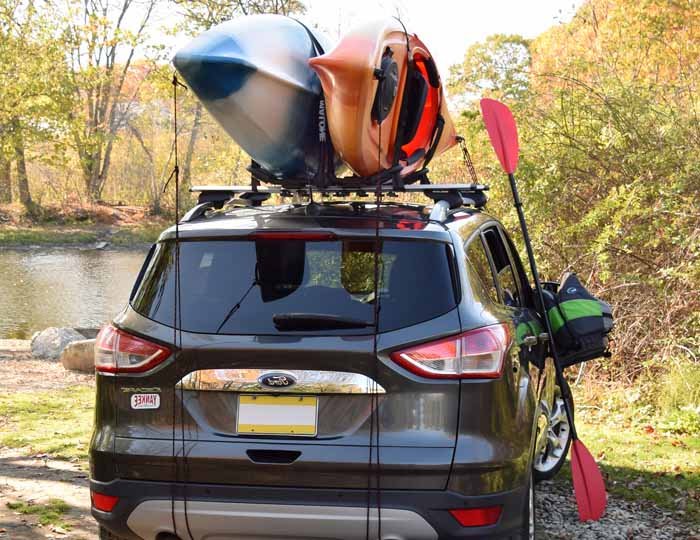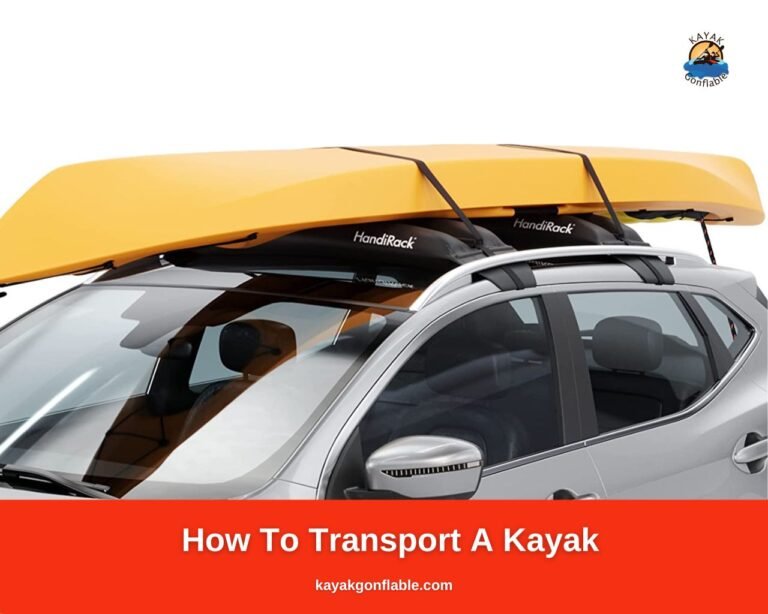Kayaking Attire For Beginners

Kayak Clothing for Beginners
Kayaking is a thrilling water sport that offers adventure seekers a chance to connect with nature and experience the serenity of paddling through various water bodies.
However, to truly enjoy the sport and stay safe, it’s crucial to understand the significance of proper kayaking attire. The right clothing and gear not only enhance your comfort but also play a vital role in ensuring your safety on the water.
Whether you’re planning a leisure paddle or embarking on a more challenging expedition, the right attire can make all the difference.
The right kayaking attire entails the right layering. There a different layers that are important when dressing for a kayak adventure. We have the base layers, outer layers, footwear, headgear, accessories, and personal floatation devices (PFDs).
Base Layer
The major function of the base layer is moisture control. Kayaking can be physically demanding and can cause perspiration. The base layer helps to regulate temperature by drawing moisture away from the body and keeps you dry.
Base layers should be made of moisture-wicking materials like synthetic fabric or merino wool. Synthetic fabrics are affordable and dry easily hence, are ideal for kayaking in the tropics.
Merino wool is suitable for various weather conditions as it is made of natural fibers that help regulate body temperature.
Outer Layers
The outer layers’ major function is to provide protection from the elements mainly the water and air. When it comes to outer layers, your choice will largely depend on the water and weather conditions you’ll encounter.
There are different types of outerwear and they fall under either of the three categories – drysuits, wetsuits, or paddling jackets.
Drysuits as the name implies keep you dry but not warm. Water is a good conductor and it rapidly conducts heat from the body which can lead to hypothermia.
Drysuits prevent the kayaker from getting wet which is very important in cold waters. When on the water, always dress for immersion even when you don’t plan to get into the water.
Drysuits provide an outer covering but do not prevent insulation against cold air. When wearing a dry suit, it is important that the base and mid-layer provide thermal insulation to keep you warm.
Wetsuits on the other hand keep you warm but don’t keep you dry. Wetsuits are made of neoprene and trap a layer of water between your body and the suit to keep you warm.
Wetsuits are better when you plan to combine kayaking with other water sports and they provide more mobility.
Paddle jackets also known as splash jackets are semi-dry lightweight jackets that protect from splash and keep you warm. They are lightweight and are suitable for warm or mild water and air temperatures.
Footwear
There are 2 important factors to consider when choosing footwear for kayaking – comfort and grip (traction). The feet aid stability and control while kayaking. Kayaking shoes protect your feet and provide the grip needed for stability and management of the kayak.
Headgear
A headgear is an important safety wear when kayaking. Helmets protect the head and are essential for whitewater kayaking while sun hats can be used on calm waters for sun protection.
Accessories
Accessories generally enhance comfort and make your kayaking experience more enjoyable. Accessories like gloves, sunglasses, and sunblock can up your kayaking adventure.
Aside from comfort, they provide protection from the elements. Gloves protect the hands from cold and blisters, sunglasses shield the eyes from the sun and water glare, while sunblock protects against sunburn.
Personal Flotation Devices (PFDs)
A PFD is not just an accessory; it’s a lifesaver. Wearing a properly fitted life jacket when kayaking provides buoyancy and safety on the water.
Choosing the right kayaking attire for the weather and water temperature allows you the leisure of enjoying the scenery without worry.
Dressing for Specific Conditions
Kayaking often exposes you to a range of weather conditions. Dressing appropriately for these conditions is essential to ensure your comfort and safety. Let’s explore how to dress for specific weather conditions:
Hot and Sunny Weather
In hot and sunny weather, your priority is staying cool and protected from the sun. Opt for clothing made from lightweight and breathable fabrics, such as moisture-wicking synthetic materials or loose-fitting, light-colored clothing.
These materials will help keep you cool by allowing air to circulate and wicking away sweat. The use of sunscreen, sunglasses, and sun hats helps protect from the sun. A high-SPF, water-resistant sunscreen protects against harmful UV rays.
You can wear a wide-brimmed hat or a kayaking cap with a visor for face and neck protection. Choose sunglasses with UV protection to shield your eyes from the sun’s glare while on the water.
Cold and Rainy Weather
When facing cold and rainy conditions, focus on insulation and waterproofing. In cold water, a dry suit or wetsuit provides the necessary insulation. Drysuits offer complete waterproof protection, while wetsuits trap a thin layer of water next to your skin, which your body heats for insulation.
Waterproof jackets and pants are important to keep rain and spray out. These layers should be breathable to prevent overheating and moisture buildup. Don’t forget to wear a properly fitted PFD, especially in cold water where hypothermia is a risk.
When out kayaking in the cold protecting your hands are feet is crucial. Neoprene gloves provide warmth and protect your hands from the cold while neoprene booties keep your feet warm and protected.
Windy Conditions
In windy conditions, staying warm and minimizing wind chill is essential. To block out the wind, wear windproof outer layers. These can be combined with insulating layers for added warmth.
To protect your neck and face, wear a neck gaiter or buff. A paddle jacket with a neoprene neck or hood provides additional protection from the chill wind. Finally, in windy conditions, ensure your clothing layers are snug to prevent cold air from penetrating.
Basic Clothing Essentials
To ensure a comfortable and enjoyable kayaking experience, it’s crucial to have the right clothing essentials. Every good kayaking attire has at least 3 basic components – the base layer, the middle layer, and the outer layer.
Moisture-Wicking Base Layer
Base layers are usually made from polyester or merino wool that draws moisture from the body to keep the kayaker dry and comfortable. The benefits of a moisture-wicking base layer are moisture management and temperature regulation.
The materials prevent discomfort caused by damp clothing and assist in temperature regulation by keeping you cool in warm weather and providing insulation in cooler conditions.
It is important to select a base layer that fits snugly without being too tight to allow freedom of movement and maximize its moisture-wicking capabilities.
Insulating Mid-Layer
A good mid-layer should provide insulation yet be breathable. While the primary role of the middle layer is to provide insulation, choosing a middle layer that can provide a good balance of warmth and breathability allows for versatility and enhanced comfort.
Materials like fleece trap warm air close to your body, keeping you comfortable in cooler weather. A breathable material prevents overheating especially in warmer conditions.
Protective Outer Layer
Your outer layer should protect you from the elements. Depending on your kayaking environment, this could be a dry suit, wetsuit, or paddling jacket. Dry suits are ideal for cold water kayaking as they offer full-body protection from water and wind.
Wetsuits are best for maintaining body heat in cooler waters and are available in different thicknesses. Paddling jackets are lightweight and waterproof, suitable for milder conditions, protecting against splashes and light rain.
Layer for Versatility
Layering is the key to adaptability. By combining base, mid, and outer layers, you can adjust your attire to meet changing conditions. For example, in cooler weather, layer a dry suit or wetsuit over your base and mid-layers for maximum insulation.
Aside from the attire itself, when kayaking it is vital to protect yourself from the sun. Protecting your head from the sun is vital. A wide-brimmed sun hat or a kayaking cap with a visor provides shade and shields your face and neck from harmful UV rays. To prevent sunburn, sunscreen is important.

Gloves for Hand Protection
Paddle-Specific Gloves
There are paddle-specific gloves designed for kayaking which provide a secure grip on your paddle, protect against blisters, and are usually made from quick-drying materials.
Cold-Weather Options
Thicker neoprene gloves or mittens are good options when kayaking in cold weather. These will keep your hands warm and maintain agility, allowing you to paddle comfortably.

Kayaking Footwear
Your choice of footwear in kayaking is vital for stability, protection, and comfort. Let’s explore the various types of kayaking footwear and how to make the right choice.
Types of Kayaking Footwear
- Water Shoes
Water shoes are versatile and suitable for various kayaking environments. They are designed to drain water quickly, preventing discomfort from soggy footwear.
Water shoes often provide good traction and toe protection. Good traction is important for stability while toe protection provides cushion from impacts.
- Neoprene Booties
Neoprene booties are excellent for kayaking in cooler waters. Made from the same material as wetsuits, they provide insulation and warmth for your feet. They come in various thicknesses to match various temperature conditions.
- Sandals with Straps
Sandals with straps are breathable footwear options and are ideal for warm-weather kayaking. The straps provide a secure fit, and the open design allows water to flow freely, keeping your feet cool. Look for models with durable, non-slip soles for reliable grip.
How To Choose the Right Footwear
When choosing footwear for kayaking, it is essential to ensure that the shoe has good grip and traction. Comfort is also important as you might be out on the water for hours or days.
It is essential that your feet remain warm and don’t go numb. Let’s consider some of the essentials to consider when choosing a kayaking footwear.
- Fit and Comfort
Your footwear should fit snugly but not too tight. Choosing the right size prevents your shoes from slipping off and provides better grip and stability.
There should be enough room for your toes to wiggle comfortably. You don’t want a shoe that restricts blood circulation to your feet. Before deciding on footwear try on different styles to find the one that suits you best.
- Grip and Traction
Grip and traction are essential for stability when kayaking as they give you better control when kayaking. Check the sole of your chosen footwear for a pattern that offers reliable traction on wet surfaces. A slip-resistant sole will help you maintain control and balance.
- Protection from Debris
When kayaking, you may encounter rocks, shells, or other debris in the water. Footwear with a durable toe guard or reinforced sole will protect your feet from injury. Neoprene booties and water shoes often come with these protective features.

PFD (Personal Flotation Device)
A Personal Flotation Device (PFD) is a non-negotiable safety essential in kayaking. The importance of PFDs in kayaking cannot be over-emphasized. They are designed to keep the user afloat in the event of capsizing or falling into the water.
Even the most experienced kayakers can find themselves in unexpected situations, and a well-fitted PFD can be what ensures safety as it provides buoyancy, allowing you to conserve energy and stay afloat.
This buoyancy can be very valuable in cold water, where hypothermia is a real danger. Having a reliable PFD gives you the confidence to explore the water with peace of mind.
Types of PFDs for Different Kayaking Activities
1. Recreational PFDs
Recreational PFDs are suitable for calm waters such as lakes and slow-moving rivers. They offer a comfortable fit and freedom of movement, making them ideal for leisurely paddling. These PFDs typically have minimal extra features to keep them lightweight.
2. Whitewater PFDs
Whitewater PFDs are designed for kayaking in fast-moving rivers and challenging conditions. They have additional padding and safety features like reinforced impact zones and rescue harnesses. These PFDs prioritize security in turbulent water.
3. Sea Kayaking PFDs
Sea kayaking PFDs are tailored for open water and coastal kayaking. They often have more pockets for storage and reflective elements for visibility. Sea kayakers may require a higher level of buoyancy due to the potential for longer rescues.
Proper PFD Fitting and Adjustment
Aside from choosing a life jacket that is suitable for the type of water you are exploring, it is important to get the right fit for your PFD to function effectively. Here are some guidelines for ensuring the right fit:
- Chest Measurement: Measure your chest at its widest point, and choose a PFD that matches your size as per the manufacturer’s instructions.
- Try It On: Always try on a PFD before purchasing it. Ensure it fits snugly without being too tight or restrictive.
Once you have the right size, adjust the straps and buckles to ensure a secure fit.
- Shoulder Straps: Adjust these first to ensure the PFD doesn’t ride up when you’re in the water. They should be snug but not tight.
- Side Straps: The side straps should be evenly adjusted on both sides for balance.
- Waist Buckle: The waist buckle secures the PFD in place and should fit snugly to prevent the PFD from riding up but not tight to cause discomfort.
- Check Range of Motion: After adjustments, test your range of motion to ensure you can paddle freely and comfortably.
Additional Gear and Accessories
In addition to the essentials of kayaking attire discussed earlier, several gear and accessories can enhance your kayaking experience and safety.
Spray Skirts and Splash Gear
Spray skirts and splash gear are vital for keeping water out of your kayak, especially in rough waters or adverse weather conditions. They create a waterproof barrier between you and the elements which helps in keeping you dry and maintain the stability of the kayak.
There are different types of spray skirts. Nylon spray skirts are ideal for recreational kayaking and are easy to put on and off. Neoprene spray skirts on the other hand provide a tighter seal and are suitable for more advanced kayakers and challenging conditions.
Safety Whistle and Communication Devices
A safety whistle is a small yet powerful tool for signaling for help in emergencies. It is an important accessory when kayaking and can be very useful when in distress.
Communication devices such as waterproof two-way radios can be invaluable for maintaining contact with fellow kayakers or emergency services if needed.
Understand Your Kayaking Environment
When it comes to kayaking, the environment in which you paddle can significantly impact your attire choices. Here, we’ll explore the different types of water bodies you might encounter on your kayaking adventures and important dressing tips for each of them.
1. Lakes and Ponds
Lakes and ponds offer serene settings for kayaking. These bodies of water are typically calm, making them suitable for beginners.
When kayaking on lakes and ponds, your attire considerations should revolve around comfort and sun protection. It is also in essential to consider the water and atmospheric conditions before choosing your attire.
2. Rivers and Rapids
For those seeking a more adventurous experience, rivers and rapids provide an exhilarating kayaking environment.
Here, you’ll face dynamic water conditions that demand specialized gear. Safety gear such as helmets and sturdy outer layers like drysuits or wetsuits are essential for river kayaking.
3. Coastal and Ocean Kayaking
Coastal and ocean kayaking introduce a new set of challenges, including unpredictable tides and waves. When exploring coastal areas or venturing into the open ocean, it’s crucial to prioritize safety by wearing a reliable PFD and suitable outer layers that can withstand exposure to saltwater.
Seasonal Considerations
Understanding the seasonal variations in your kayaking environment is essential for choosing the right attire. Each season brings its own set of challenges and opportunities:
Spring, Summer, Fall, and Winter Kayaking
- Spring: As the weather warms up, you’ll want to transition to lighter attire. Depending on your location, a moisture-wicking base layer with a paddling jacket or wetsuit might suffice. Don’t forget sun protection, as the sun’s intensity increases.
- Summer: In hot weather, opt for breathable clothing and stay hydrated. Lightweight paddling attire, sunglasses, and sunscreen are vital.
- Fall: As temperatures drop, consider thicker wetsuits or dry suits to keep warm. Layers are your friend, as you can adjust them as needed.
- Winter: Extreme cold requires specialized gear. A dry suit with insulating layers underneath is the best choice for winter kayaking. Neoprene gloves and booties are essential to prevent frostbite.
Temperature and Weather Variations
Remember that even within a season, weather conditions can vary. Pay attention to temperature forecasts, wind speeds, and the likelihood of rain or storms.
Always be prepared to adjust your attire accordingly. A sudden drop in temperature can make a seemingly pleasant day on the water uncomfortable without the right gear.
Understanding your kayaking environment is essential for selecting the right attire. Different types of water bodies and seasonal variations require tailored clothing and gear choices to ensure both comfort and safety.
Selecting the right materials and layering according to the type of kayaking adventure and weather will aid your comfort and safety. Each component is equally important as they collectively contribute to a successful and enjoyable kayaking adventure.






